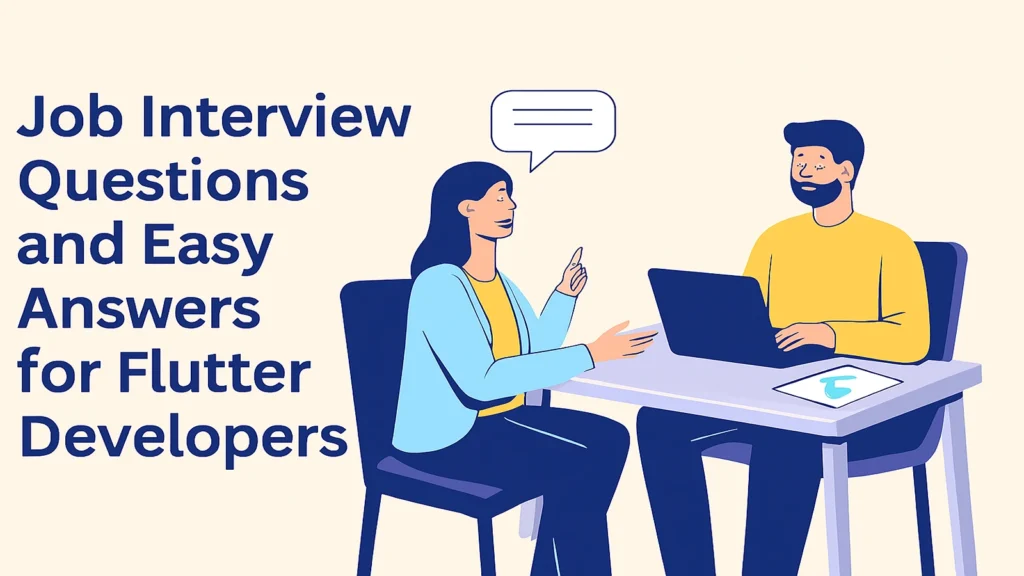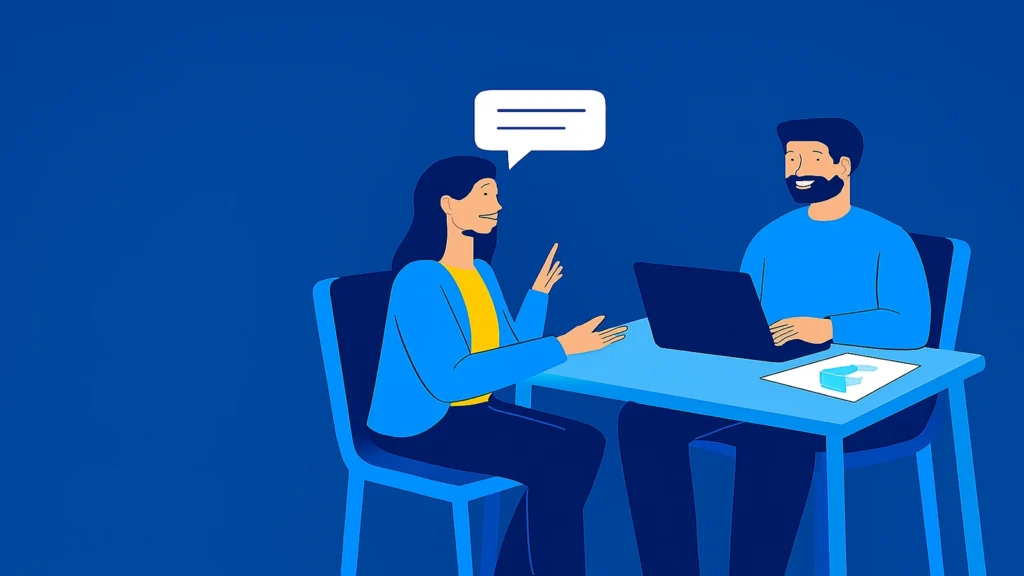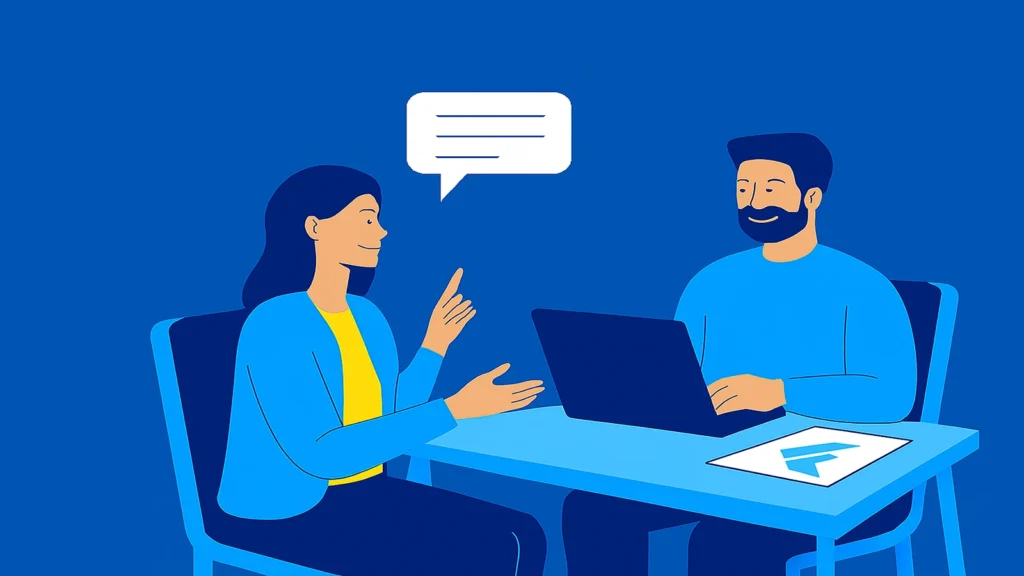Flutter has become one of the most popular cross-platform mobile development frameworks, and with its growing adoption, the demand for skilled Flutter developers continues to rise. Whether you’re a junior developer preparing for your first Flutter interview or an experienced developer looking to switch roles, having a solid understanding of common interview questions can make all the difference.
This comprehensive guide covers 100 essential Flutter interview questions across different difficulty levels, from basic concepts to advanced topics. Each question comes with clear, concise answers that will help you demonstrate your Flutter expertise confidently.
Basic Flutter Concepts (Questions 1-25)

1. What is Flutter?
Flutter is Google’s open-source UI software development kit for creating natively compiled applications for mobile, web, and desktop from a single codebase. It uses the Dart programming language and provides a rich set of pre-designed widgets.
2. What are the main advantages of Flutter?
- Single codebase for multiple platforms
- Fast development with hot reload
- High performance with native compilation
- Rich set of customizable widgets
- Strong community support
- Backed by Google
3. What is Dart and why does Flutter use it?
Dart is a client-optimized programming language developed by Google. Flutter uses Dart because it compiles to native code, supports both AOT and JIT compilation, has a garbage collector, and provides strong typing with null safety.
4. What is a Widget in Flutter?
A Widget is the basic building block of a Flutter app’s user interface. Everything in Flutter is a widget, from basic elements like text and buttons to complex layouts and animations.
5. What’s the difference between StatelessWidget and StatefulWidget?
- StatelessWidget: Immutable widgets that don’t change their state during the app’s lifetime. They’re rebuilt only when their parent changes.
- StatefulWidget: Mutable widgets that can change their state during runtime using the
setState()method.
6. What is the widget tree in Flutter?
The widget tree is a hierarchical structure that represents the UI of a Flutter app. Each widget is a node in the tree, with parent-child relationships defining the layout and structure.
7. Explain Hot Reload in Flutter.
Hot Reload allows developers to see changes in their code almost instantly without restarting the app or losing the current app state. It injects updated source code into the running Dart VM.
8. What is the difference between Hot Reload and Hot Restart?
- Hot Reload: Preserves app state and updates the UI quickly
- Hot Restart: Restarts the app and loses the current state but applies all code changes
9. What is the pubspec.yaml file?
pubspec.yaml is the configuration file for a Flutter project that defines metadata, dependencies, assets, and other project settings.
10. What is the main() function in Flutter?
The main() function is the entry point of a Flutter application. It typically calls runApp() with the root widget of the app.
11. What is MaterialApp?
MaterialApp is a convenience widget that wraps several widgets commonly required for Material Design applications, including Navigator, Theme, and MediaQuery.
12. What is Scaffold?
Scaffold provides the basic material design visual layout structure, including app bar, body, floating action button, drawer, and bottom navigation.
13. What are some commonly used layout widgets?
- Container
- Row and Column
- Stack
- Expanded and Flexible
- Wrap
- ListView
- GridView
14. What is the Container widget?
Container is a convenience widget that combines common painting, positioning, and sizing widgets. It can contain decoration, padding, margin, and constraints.
15. What’s the difference between Row and Column?
- Row: Arranges children horizontally (main axis is horizontal)
- Column: Arranges children vertically (main axis is vertical)
16. What is MainAxisAlignment and CrossAxisAlignment?
- MainAxisAlignment: Controls how children are positioned along the main axis
- CrossAxisAlignment: Controls how children are positioned along the cross axis
17. What is the Expanded widget?
Expanded forces a child of Row, Column, or Flex to fill the available space along the main axis.
18. What’s the difference between Expanded and Flexible?
- Expanded: Forces the child to fill available space
- Flexible: Allows the child to occupy available space but doesn’t force it
19. What is a ListView?
ListView is a scrollable list of widgets arranged linearly. It’s commonly used for displaying lists of data.
20. What are the different types of ListView?
- ListView() – Basic constructor
- ListView.builder() – Creates items on demand
- ListView.separated() – Includes separators between items
- ListView.custom() – Uses a custom SliverChildDelegate
21. What is GridView?
GridView is a scrollable 2D array of widgets. It’s useful for displaying items in a grid format.
22. What is Stack widget?
Stack allows you to overlay widgets on top of each other. Children are positioned relative to the stack’s edges.
23. What is Positioned widget?
Positioned is used within Stack to position a child widget at specific coordinates relative to the stack.
24. What is the AppBar widget?
AppBar is a Material Design app bar that typically contains a title, leading/trailing actions, and can include tabs or other widgets.
25. What is FloatingActionButton?
FloatingActionButton is a circular icon button that hovers over content to promote a primary action in the application.
Intermediate Flutter Concepts (Questions 26-60)
26. What is State Management in Flutter?
State management refers to how you handle and update the state of your application. It’s crucial for building reactive and maintainable apps.
27. What are different state management approaches in Flutter?
- setState()
- InheritedWidget
- Provider
- Riverpod
- BLoC/Cubit
- Redux
- GetX
- MobX
28. What is Provider pattern?
Provider is a state management solution that uses InheritedWidget to propagate data down the widget tree efficiently.
29. What is BLoC pattern?
BLoC (Business Logic Component) separates business logic from UI using streams. It uses events as input and states as output.
30. What is the difference between Cubit and BLoC?
- Cubit: Simpler, uses functions to emit states
- BLoC: More complex, uses events and mapEventToState
31. What are Streams in Dart?
Streams provide a way to receive a sequence of events. They’re used for handling asynchronous data like user input, file I/O, or web requests.
32. What is async and await in Dart?
async and await are used to handle asynchronous operations. async marks a function as asynchronous, and await pauses execution until a Future completes.
33. What is Future in Dart?
Future represents a potential value or error that will be available at some time in the future. It’s used for asynchronous operations.
34. What is FutureBuilder?
FutureBuilder is a widget that builds itself based on the latest snapshot of interaction with a Future.
35. What is StreamBuilder?
StreamBuilder is a widget that builds itself based on the latest snapshot of interaction with a Stream.
36. What are Isolates in Dart?
Isolates are independent workers that run in parallel to the main thread. They don’t share memory and communicate through message passing.
37. What is the Navigator in Flutter?
Navigator manages a stack of Route objects and provides methods for managing the stack (push, pop, replace).
38. What is routing in Flutter?
Routing is the mechanism for navigating between different screens/pages in a Flutter application.
39. What’s the difference between Navigator.push() and Navigator.pushNamed()?
- Navigator.push(): Directly pushes a route object
- Navigator.pushNamed(): Uses named routes defined in MaterialApp
40. What are named routes?
Named routes allow you to navigate using string identifiers instead of constructing route objects directly.
41. How do you pass data between screens?
- Constructor arguments
- Route arguments
- Global state management
- InheritedWidget
42. What is Hero animation?
Hero animation creates a smooth transition effect when navigating between screens by animating a widget from one screen to another.
43. What are animations in Flutter?
Animations in Flutter are used to create smooth transitions and interactive effects. They’re built on Animation objects and AnimationController.
44. What is AnimationController?
AnimationController controls an animation’s duration, direction, and provides methods to start, stop, and reverse animations.
45. What is Tween?
Tween defines the range of values an animation can take. It maps animation values to specific types like colors, sizes, or positions.
46. What are implicit animations?
Implicit animations are pre-built animated widgets that automatically animate property changes, like AnimatedContainer or AnimatedOpacity.
47. What are explicit animations?
Explicit animations give you full control over the animation process using AnimationController and custom Animation objects.
48. What is CustomPainter?
CustomPainter allows you to create custom graphics by painting directly on a canvas using drawing commands.
49. What is Form validation in Flutter?
Form validation ensures user input meets specific criteria. Flutter provides Form widget and TextFormField with validator functions.
50. What is GlobalKey?
GlobalKey provides access to the state of a widget from anywhere in the widget tree. It’s commonly used with Forms.
51. What are Gestures in Flutter?
Gestures detect user interactions like taps, drags, and swipes. Flutter provides GestureDetector and specific gesture recognizers.
52. What is GestureDetector?
GestureDetector is a widget that detects gestures and provides callbacks for various gesture events.
53. What is InkWell?
InkWell is similar to GestureDetector but provides Material Design ink splash effects when tapped.
54. What is TextField vs TextFormField?
- TextField: Basic text input widget
- TextFormField: TextField integrated with Form widget, includes validation
55. What is Focus in Flutter?
Focus manages keyboard focus and determines which widget receives keyboard events.
56. What are Keys in Flutter?
Keys are used to preserve state when widgets move around in the widget tree. Common types include ValueKey, ObjectKey, and UniqueKey.
57. What is the difference between ListView and SingleChildScrollView?
- ListView: Optimized for large lists, builds items on demand
- SingleChildScrollView: Loads all content at once, suitable for smaller scrollable content
58. What is Sliver?
Slivers are scrollable areas that can be composed together to create custom scroll effects in CustomScrollView.
59. What is CustomScrollView?
CustomScrollView allows you to create custom scroll effects by combining different sliver widgets.
60. What is the difference between initState() and build()?
- initState(): Called once when StatefulWidget is created, used for initialization
- build(): Called every time the widget needs to be redrawn
Advanced Flutter Concepts (Questions 61-85)

61. What is the widget lifecycle in Flutter?
The lifecycle includes: createState(), initState(), didChangeDependencies(), build(), didUpdateWidget(), deactivate(), and dispose().
62. Explain the build context.
BuildContext is a handle to the location of a widget in the widget tree. It provides access to inherited widgets and theme data.
63. What is InheritedWidget?
InheritedWidget allows data to be efficiently passed down through the widget tree without explicitly passing it through constructors.
64. What is the difference between StatefulWidget and InheritedWidget?
- StatefulWidget: Manages its own state
- InheritedWidget: Shares data with descendant widgets
65. What are Mixins in Dart?
Mixins are a way to reuse code in multiple class hierarchies. They’re used with the with keyword.
66. What is the difference between extends, implements, and with?
- extends: Inherits from a superclass
- implements: Must implement all methods of a class/interface
- with: Uses mixins to share functionality
67. What is null safety in Dart?
Null safety prevents null reference errors by making the type system distinguish between nullable and non-nullable types.
68. What are late variables in Dart?
Late variables are non-nullable variables that are initialized after declaration, useful for expensive computations or circular dependencies.
69. What is Platform Channel?
Platform Channels enable communication between Dart code and platform-specific code (iOS/Android) for accessing native APIs.
70. How do you handle platform-specific code?
Use Platform Channels, conditional imports, or packages like dart:io to detect platforms and implement platform-specific functionality.
71. What is a Plugin vs Package in Flutter?
- Package: Contains only Dart code
- Plugin: Contains Dart code and platform-specific implementations
72. What is dependency injection?
Dependency injection is a design pattern where dependencies are provided to a class rather than the class creating them itself.
73. What is the Repository pattern?
Repository pattern abstracts data access logic and provides a consistent interface for accessing data from different sources.
74. What is Clean Architecture in Flutter?
Clean Architecture separates code into layers (presentation, domain, data) with clear dependencies, making code more testable and maintainable.
75. What is testing in Flutter?
Flutter supports unit tests, widget tests, and integration tests to ensure code quality and functionality.
76. What are the different types of tests in Flutter?
- Unit tests: Test individual functions or classes
- Widget tests: Test widget behavior and UI
- Integration tests: Test the complete app flow
77. What is the testWidgets function?
testWidgets is used for widget testing, providing a WidgetTester to interact with widgets in a test environment.
78. What is MockTail/Mockito?
MockTail and Mockito are libraries for creating mock objects in tests to simulate dependencies and external services.
79. What is golden testing?
Golden testing compares the visual output of widgets against reference images to catch visual regressions.
80. What is performance optimization in Flutter?
Performance optimization involves reducing widget rebuilds, optimizing images, using const constructors, and proper list handling.
81. What is const constructor?
Const constructors create compile-time constants, reducing memory usage and improving performance by reusing widget instances.
82. How do you optimize ListView performance?
Use ListView.builder(), implement proper itemExtent, use AutomaticKeepAliveClientMixin, and optimize item widgets.
83. What is the difference between debug and release builds?
- Debug: Includes debugging information, hot reload, slower performance
- Release: Optimized for production, smaller size, better performance
84. What is tree shaking in Flutter?
Tree shaking removes unused code from the final build, reducing app size by eliminating dead code.
85. What are build modes in Flutter?
Flutter has three build modes: debug (development), profile (performance analysis), and release (production).
Flutter Ecosystem & Tools (Questions 86-100)

86. What is Firebase and how is it integrated with Flutter?
Firebase is Google’s mobile and web application development platform. Flutter integrates with Firebase through official plugins for authentication, database, storage, and more.
87. What is FlutterFire?
FlutterFire is the official set of Flutter plugins that connect Flutter apps to Firebase services.
88. What is REST API integration in Flutter?
REST API integration involves making HTTP requests using packages like http or dio to communicate with web services.
89. What is JSON serialization in Flutter?
JSON serialization converts Dart objects to JSON and vice versa. Flutter supports manual serialization and code generation with libraries like json_annotation.
90. What is the http package?
The http package provides methods for making HTTP requests (GET, POST, PUT, DELETE) to web APIs.
91. What is Dio package?
Dio is a powerful HTTP client for Dart with features like interceptors, request cancellation, file downloading, and timeout handling.
92. What is shared_preferences?
shared_preferences is a plugin for storing simple key-value data persistently on device storage.
93. What is SQLite integration in Flutter?
SQLite integration is achieved using packages like sqflite to store and query relational data locally.
94. What is Hive in Flutter?
Hive is a lightweight, fast NoSQL database for Flutter and Dart applications, suitable for local data storage.
95. What is internationalization (i18n) in Flutter?
Internationalization is the process of designing an app to support multiple languages and regions using the intl package.
96. What is responsive design in Flutter?
Responsive design ensures apps work well across different screen sizes and orientations using MediaQuery, LayoutBuilder, and flexible widgets.
97. What are Flutter Inspector and DevTools?
- Flutter Inspector: Visual debugging tool for examining widget tree
- DevTools: Comprehensive debugging and profiling suite for Flutter apps
98. What is code generation in Flutter?
Code generation uses tools like build_runner to automatically generate code, commonly used for JSON serialization and dependency injection.
99. What is the difference between debug console and Flutter Inspector?
- Debug console: Text-based debugging output
- Flutter Inspector: Visual tool for inspecting widget properties and layout
100. What are some best practices for Flutter development?
- Use const constructors when possible
- Implement proper state management
- Follow naming conventions
- Write comprehensive tests
- Optimize for performance
- Handle errors gracefully
- Use proper project structure
- Keep widgets small and focused
- Document your code
- Stay updated with Flutter releases
Conclusion
Mastering these 100 Flutter interview questions will significantly boost your confidence and performance in Flutter development interviews. Remember that technical interviews aren’t just about memorizing answers—understanding the underlying concepts and being able to discuss trade-offs and real-world applications is equally important.
Practice building Flutter apps, contribute to open-source projects, and stay updated with the latest Flutter developments. Good luck with your Flutter interviews!
Read More: Hire Flutter Developer: How to Find the Perfect Match for Your App Project
